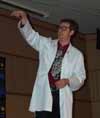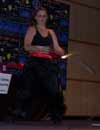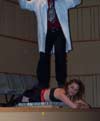’It’s not hard to see an overall lack of critical thinking here in the United States. If you pause for about one millisecond you can probably come up with a few examples… or you could simply peruse any of the pages on my website.
Humans are really not very good at thinking skeptically. Evolution, ironically, has us all too willing to believe leaders, subserve to authority, accept fantasy as reality. We have to learn to think, and it’s hard. By the time we’re adults, it’s even harder.
That’s why it’s so important to teach how to think to kids. How many kids learn that science is just a big pile of facts, and never learn that it’s actually a rich tapestry of learning, a method, a way of thinking, a complex and beautiful interaction of humans, emotions, insights, drama, and the sheer joy of discovery?
We need to reach kids. And hooray for the good guys, some people are!
 | Enter the Mystery Investigators. This is the team of Alynda Brown and Richard Saunders, two Australian skeptics (check out their magazine, featuring an interview with moi in the April 2005 issue). I’m proud to say they are my friends, because, by every definition I accept, they are heroes. They go into classrooms and teach kids how to think, by showing them where thinking goes wrong. And most importantly, they make it fun! |
One demo they did I liked very much: they said they were going to find out who in the room was psychic. They start off by saying that one person in the room can predict the future, and we can find out who! They get everyone in the audience to stand up, and have them pick “heads” or “tails” (by pointing at their head or their tail). They asked me to flip a coin, and everyone who guessed wrong had to sit down. The people who remained standing once again were asked to choose heads or tails, and I flipped the coin again, and so on. In our audience, there were about 120 people, so I knew it would take about six flips to eliminate everyone but two (I won’t tell you why– figure it out!). I then did the final flip, and presto: one person was left! Clearly, she must be psychic to have known in advance what seven coin flips would be!
It’s rather like the lottery. Someone has to win. But the odds are pretty good it won’t be you.
It’s the way they end the show that really gets me, though. They pull out a rolled up poster from behind the table. Unfurling it reveals an ochre and rust panorama, a detailed, 6 foot long picture showing the surface of Mars as taken by one of the two rovers currently exploring the landscape there. The image is a triumph of engineering and science.
The look out into the audience and say, “Let’s see an astrologer do this!”
Teaching kids lessons like these will make them better people. They’ll be less likely to be fooled by charlatans, and far more able to make important decisions later in life. Go to the Mystery Investigators website; they are willing to travel. I just bet you know a school that could use a show like this.’

